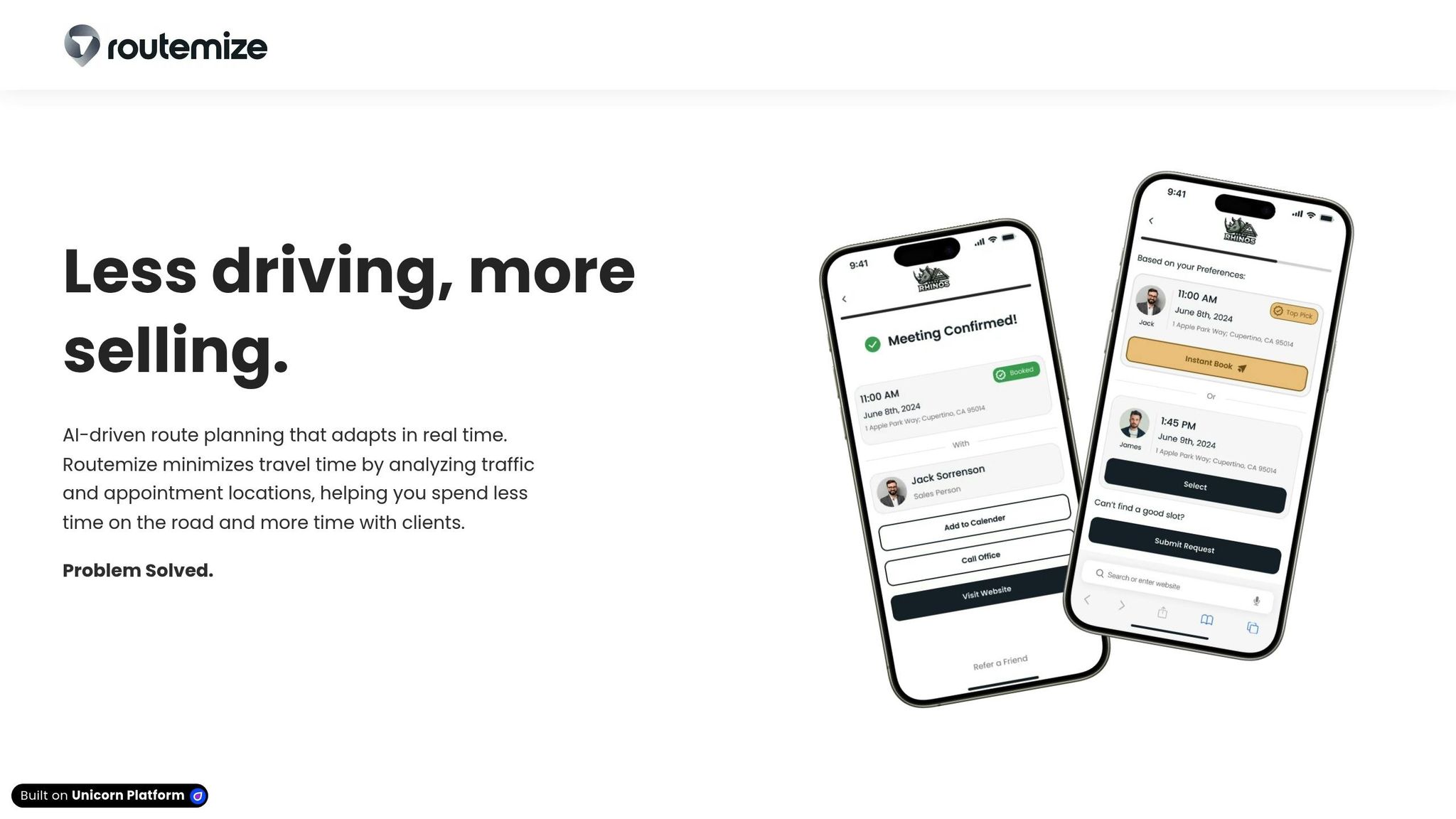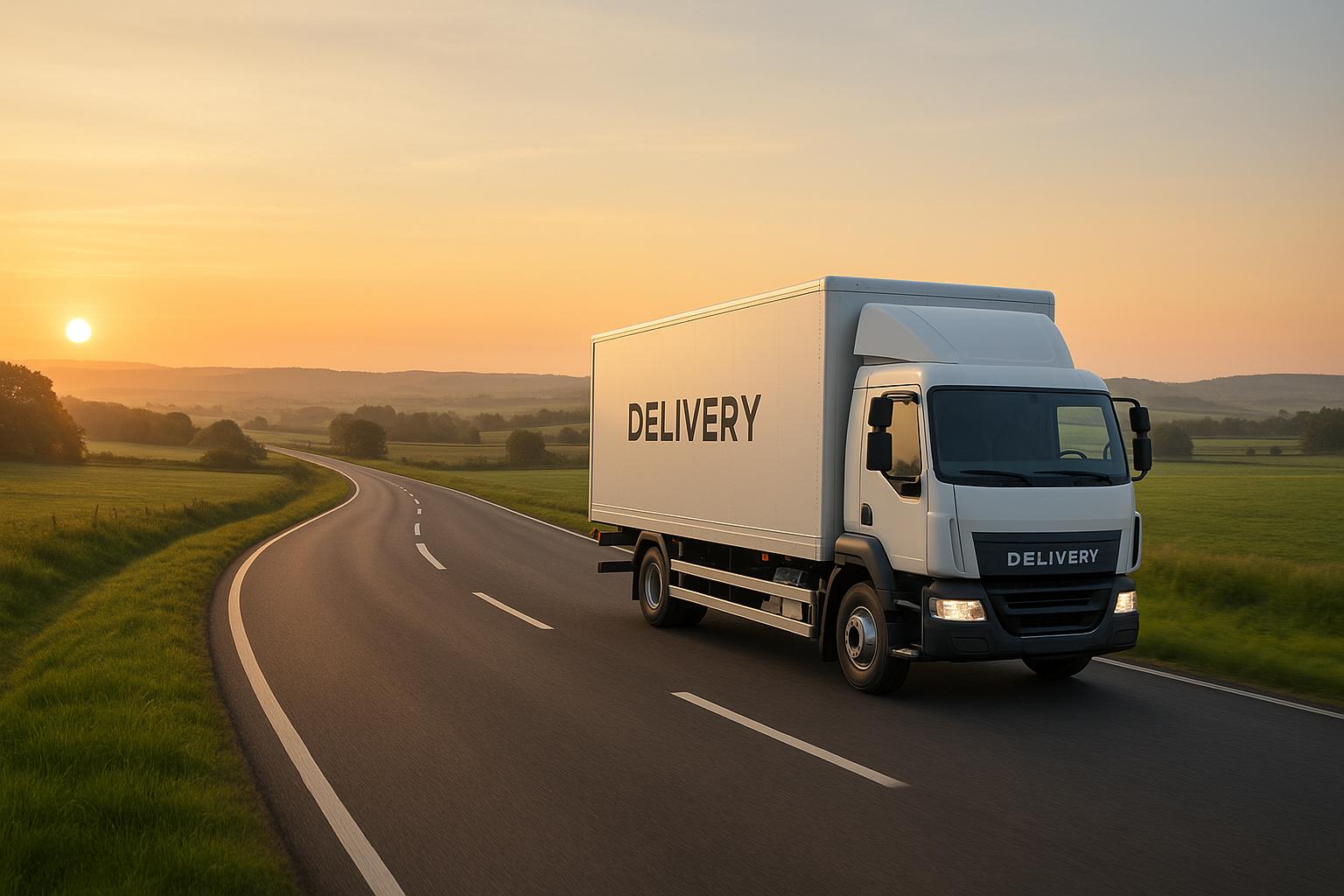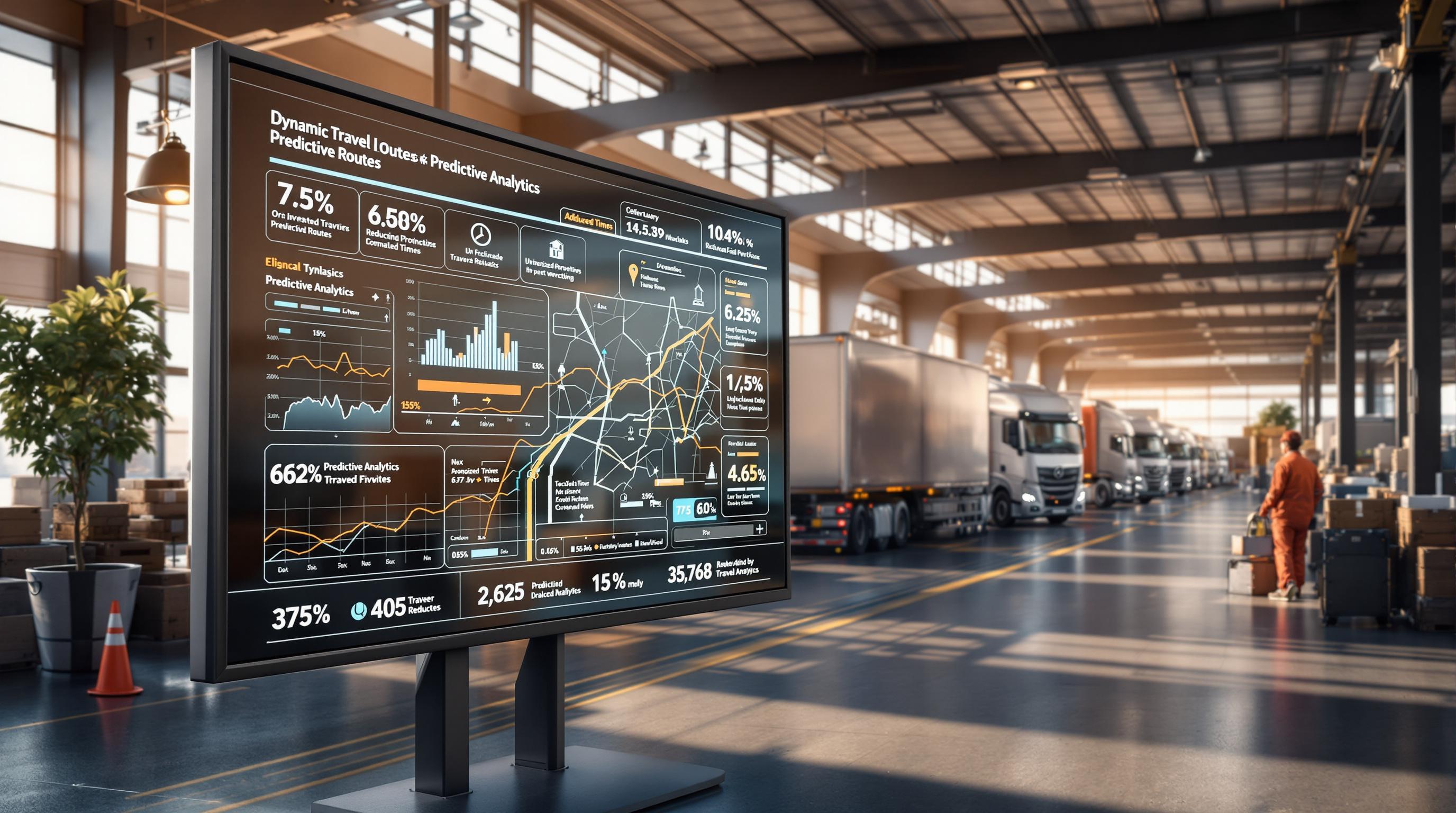Route planning is essential for service providers looking to save costs, improve efficiency, and enhance customer satisfaction. AI-powered tools are transforming the process, offering smarter, faster solutions compared to manual methods. Here's what you need to know:
-
Why Route Planning Matters:
- Reduces fleet operation costs by up to 33%.
- Cuts unnecessary mileage by up to 50%.
- Boosts customer satisfaction with accurate arrival times and real-time updates.
-
AI vs Manual Planning:
- AI handles real-time traffic, weather, and road data for constant route adjustments.
- Manual planning relies on static maps and requires more time and effort.
- AI improves delivery efficiency by 15–25% and cuts transportation costs by 20–30%.
-
Key Benefits:
- Cost Savings: Reduces fuel use and travel time, saving millions annually.
- Customer Experience: Shorter wait times, precise ETAs, and fewer late deliveries.
- Operational Efficiency: Automates bulk order processing in minutes.
-
Choosing the Right Tools:
- Ensure compatibility with GPS, ERP, and CRM systems.
- Look for mobile features like real-time updates, GPS navigation, and digital proof of delivery.
- Opt for scalable, cloud-based platforms to support business growth.
-
Implementation Tips:
- Use accurate data and integrate systems seamlessly.
- Train employees on AI basics, risk management, and software usage.
- Balance automation with human judgment for special requests and unforeseen events.
Quick Comparison:
| Feature | AI-Powered Planning | Manual Planning |
|---|---|---|
| Data Handling | Real-time traffic & weather | Static maps & past data |
| Route Adjustments | Automatic, continuous | Manual changes required |
| Processing Time | Minutes for bulk orders | Hours for similar tasks |
| Cost Savings | Up to 30% | Limited |
| Customer Satisfaction | Higher due to accurate ETAs | Lower due to delays |
AI-powered route optimization is no longer a luxury - it's a necessity for service providers aiming to stay competitive in today's fast-moving logistics landscape.
Optimizing Last Mile Delivery Efficiency with AI Powered Routing Solutions
Understanding AI Route Optimization
AI is reshaping how businesses approach route planning, offering smarter and faster solutions for improving service delivery.
Core Components
AI-based route optimization goes beyond older methods by analyzing multiple data streams in real time. It relies on three key elements:
- Machine Learning: Uses historical and live data to predict the best routes.
- Neural Networks: Examines traffic patterns and weather conditions for better decision-making.
- Real-Time Data Integration: Incorporates live updates like road closures or accidents to keep routes efficient.
These systems process factors like traffic, weather, delivery constraints, and road conditions, allowing for constant adjustments throughout the day.
Impact on Service Delivery
By combining these components, AI turns route planning into a powerful tool for improving operations. Studies show that AI solutions can reduce transportation costs by 20–30%, improve delivery efficiency by 15%, and increase productivity by 25%. For example, FarEye’s system slashes bulk order allocation times from hours to just 30 minutes.
AI vs Manual Planning
The contrast between AI and manual route planning is stark:
| Feature | AI-Powered Planning | Manual Planning |
|---|---|---|
| Data Handling | Real-time traffic, weather, and road data | Static maps and past information |
| Route Adjustments | Automatic, continuous updates | Requires manual changes |
| Processing Time | Handles bulk orders in 30 minutes | Takes hours for similar tasks |
| Resource Optimization | Automated task allocation | Relies on manual effort |
| Error Management | Predicts and prevents issues | Reacts after problems occur |
This comparison underscores how AI outperforms manual planning. While manual methods depend on human input and outdated tools, AI systems can juggle multiple variables - like fuel usage and delivery deadlines - at the same time. The result? Noticeable gains in efficiency and accuracy.
Cost and Time Savings
AI's role in improving service delivery extends to cutting costs and saving time through better route planning.
Fuel and Travel Costs
Smarter route planning powered by AI can significantly reduce expenses. For example, UPS's On-Road Integrated Optimization and Navigation (ORION) platform saved the company $320 million and cut fuel use by 10 million gallons during its initial rollout.
Globally, poor routing contributes to delivery costs rising by as much as 30%. In the U.S. alone, traffic congestion costs businesses $87 billion each year. Advanced routing tools help tackle these challenges, turning inefficiencies into savings.
Smart Scheduling
Some route planning software evaluates over 120 variables, boosting routing efficiency by an impressive 300% - without needing more vehicles or drivers. Precise scheduling is critical. Research shows 17% of customers leave a service provider after just one late delivery, and 55% after two or three late deliveries.
Live Updates and Changes
Around 69% of companies adjust delivery routes in real time, with 39% making multiple changes daily. For instance, a meal delivery service using real-time optimization saw a 30% improvement in delivery times, a 40% drop in late deliveries, a 15% reduction in fuel costs, and a 25% increase in customer satisfaction.
"The ability to set an effective strategy and create optimized standards that minimize real-time chaos while balancing cost efficiency and delivery accuracy is no longer a luxury - it's a necessity in today's fast-moving logistics environment." – Mat Witte, CEO of ORTEC Americas
Weather-related delays cost trucking companies $3.5 billion annually. By incorporating live traffic updates, weather conditions, and vehicle data, modern routing systems help businesses avoid disruptions and stick to efficient schedules. This real-time adaptability highlights AI's growing importance in managing routes effectively and cutting costs.
Key Software Requirements
Choosing the right route optimization software can make a big difference in streamlining your operations.
System Compatibility
The software you select should work seamlessly with your existing business tools. For instance, NextBillion.ai's API connects with telematics systems to provide live tracking and alerts, cutting down on manual data entry and reducing cross-platform errors.
Some essential integration points to consider include:
- GPS and telematics systems for real-time vehicle tracking
- Enterprise Resource Planning (ERP) software
- Customer Relationship Management (CRM) platforms
- Logistics management tools already in use
Tools like Onfleet are designed to integrate easily with various systems, making them a practical choice for businesses managing complex operations.
Growth and Flexibility
As your business grows, your software should grow with it. Cloud-based platforms are especially helpful because they can adjust to support anything from a small fleet to large-scale operations.
Key areas the software should support include:
- Managing more drivers and vehicles
- Expanding service regions
- Handling increased delivery volumes
- Accommodating multiple routing modes within a single platform
Mobile Features
Mobile access is another must-have for real-time operations. The right software should offer tools that help field teams stay efficient and connected. Here’s what to look for:
| Feature | Benefit |
|---|---|
| Real-time route updates | Helps drivers adjust to changing conditions on the fly |
| GPS navigation | Provides accurate, turn-by-turn directions |
| Delivery window management | Keeps teams on schedule and ensures customer satisfaction |
| Status updates | Facilitates quick communication between drivers and dispatch |
| Digital proof of delivery | Simplifies documentation for completed deliveries |
Dynamic route optimization is key for handling real-time challenges like traffic, weather, or delays. To get the most out of your software, prioritize tools that are not only customizable but also easy to use, even for team members with varying levels of technical expertise.
sbb-itb-7020db0
Common Implementation Issues
Implementing AI route planning comes with its share of challenges. Here's a breakdown of key issues and how to tackle them effectively.
Setup Process
To ensure smooth implementation, it's critical to use accurate, up-to-date data. This minimizes risks like delayed deliveries or missed stops. Focus on these crucial setup components:
| Setup Component | Key Requirements | Common Pitfalls |
|---|---|---|
| Data Quality | Real-time updates, precise addresses | Outdated or incorrect customer details |
| System Integration | API compatibility, legacy system connections | Software version mismatches |
| Resource Planning | Sufficient hardware and bandwidth | Limited server capacity |
| Cost Management | Clear understanding of licensing and training costs | Unexpected or hidden expenses |
When integrating AI routing tools, choose options with strong API capabilities. This ensures smooth data flow and minimizes disruptions. Once your systems and data are ready, invest in targeted training to prepare your team for the transition.
Employee Training
Switching to AI-powered routing requires a well-thought-out training plan to help employees adapt. A great example is Walmart, which used Axonify's microlearning approach to boost both knowledge retention and employee engagement when introducing new routing systems.
Key areas to cover in training include:
- Basic AI concepts: Understanding how the system makes decisions.
- Risk assessment: Recognizing potential issues with AI-generated routes.
- Data privacy: Following company policies and regulations.
- Practical application: Hands-on practice with the routing software.
Human Input vs AI
Balancing automation with human oversight is essential. While AI is great at processing data and optimizing routes, human judgment is irreplaceable in certain scenarios. Here's a comparison of where AI excels and where human input is critical:
| Situation | AI Capability | Human Input Needed |
|---|---|---|
| Road Closures | Limited real-time updates | Adjusting routes manually |
| Weather Events | Basic forecasting | Strategic rerouting based on experience |
| Driver Preferences | Standard optimization | Customizing routes based on familiarity |
| Special Requests | Basic scheduling | Managing customer-specific needs |
Customer Service Improvements
AI-powered route optimization is transforming customer service by improving delivery times and offering greater scheduling flexibility. Major companies have shown how these advancements lead to better arrival accuracy, shorter wait times, and the ability to adapt schedules quickly.
Arrival Time Accuracy
AI systems use real-time data to make delivery time predictions more precise. For example, UPS's ORION system analyzes traffic patterns, weather, and historical data to provide accurate ETAs. This approach has not only improved delivery reliability but also saved UPS millions of miles annually.
| Service Metric | Traditional Planning | AI-Powered Planning |
|---|---|---|
| Transit Time Reduction | Baseline | Up to 20% improvement |
| ETA Accuracy | Variable | Real-time updates |
| Customer Notifications | Manual | Automated alerts |
| Service Reliability | Inconsistent | Consistently high |
Accurate ETAs naturally minimize customer wait times, enhancing overall satisfaction.
Shorter Wait Times
AI-driven route optimization significantly reduces how long customers wait for deliveries. For instance, a delivery-tour planning algorithm cut average wait times by about 30%. Similarly, DHL's smart trucking solutions in India achieved a 20% reduction in transit times while improving service efficiency.
"Ensuring the efficient delivery of items in minimum time, i.e., minimizing customer waiting time from order to delivery, is central to ensuring the reliability of this 'convenience.'"
- Hiroshi Uchigaito, Research & Development Group, Hitachi, Ltd
Faster deliveries require systems that can adjust quickly to changing conditions.
Quick Schedule Changes
AI routing systems excel at managing last-minute changes. Domino's, for example, uses an AI-driven platform to predict order volume and optimize delivery routes. This system recalculates routes instantly, reallocates resources during busy times, and prioritizes urgent orders automatically.
"AI routing systems can efficiently manage thousands of delivery routes, considering a myriad of constraints such as vehicle types, delivery priorities, and traffic conditions."
- Komal Puri, AVP Marketing at FarEye
With 74% of mobile workers reporting that customer expectations are higher than ever, companies like Amazon are using dynamic route planning to meet these demands. This approach enhances last-mile delivery performance and ensures customer satisfaction.
Routemize: Route Planning in Action

Routemize demonstrates how AI-powered tools can make route planning more efficient and practical.
Main Tools
Routemize leverages advanced AI to streamline route planning and improve service operations. By analyzing traffic patterns and grouping appointments, it helps businesses save time and resources.
| Feature | Benefit | Impact |
|---|---|---|
| AI Route Planning | Creates efficient travel paths | Cuts fuel costs by up to 30% |
| Real-time Traffic Analysis | Adjusts routes on the fly | Reduces delays and sharpens ETAs |
| Appointment Location Grouping | Clusters nearby service calls | Lowers total miles driven |
| Client Schedule Management | Aligns service windows | Boosts first-time visit success rates |
These features translate directly into more efficient operations and lower costs.
Service Provider Results
The impact of these tools is clear. Transportation costs make up 10.4% of total revenue for U.S. businesses, equating to over $1.04 trillion annually. Companies that adopt route optimization solutions report noticeable improvements in key performance areas.
Routemize's centralized dashboard simplifies logistics management. It allows service providers to monitor delivery performance, assess driver productivity, evaluate route efficiency, and maintain customer communication with ease.
Cost Options
Routemize is currently in beta, offering early adopters free access to its complete feature set.
For context, similar tools often use volume-based pricing models:
| Usage Level | Price Point | Features |
|---|---|---|
| Basic (1,000 orders) | $150.00 flat rate | Full platform access |
| Additional Orders | $0.15 per order | Volume discounts available |
| Enterprise | Custom pricing | Unlimited drivers and dispatchers |
Routemize focuses on reducing operational costs by improving route efficiency. Businesses using it typically see savings in fuel, labor, and vehicle maintenance expenses. Unlike basic mapping tools, Routemize is tailored for the complex needs of service delivery operations.
Conclusion
Key Points
AI-powered route optimization has become a game-changer for service providers aiming to improve efficiency and keep customers happy. This technology can cut transportation costs by as much as 20% while enhancing overall operations. Here's how it makes an impact:
| Area of Impact | Benefits |
|---|---|
| Operational Efficiency | Real-time route updates and fewer empty miles traveled |
| Cost Management | Lower transportation costs (up to 20%) and less fuel consumption |
| Customer Experience | More precise arrival estimates and quicker response times |
| Environmental Impact | Reduced carbon emissions through better route planning |
| Resource Utilization | Improved vehicle usage and better load management |
These insights can serve as a roadmap for introducing AI-driven routing into your operations.
Getting Started
To begin integrating AI-powered route optimization, follow these steps:
- Review Current Processes: Analyze your current routing methods to pinpoint areas where AI can bring immediate benefits.
- Set Clear Goals: Define specific targets, such as cutting travel time, lowering fuel expenses, or improving customer satisfaction.
- Select the Right Tools: Choose software that integrates seamlessly with your existing systems and meets your business needs.
- Train Your Team: Ensure smooth adoption by providing thorough training for your staff.
This approach ensures you achieve the operational and customer service improvements highlighted above.
"AI-driven route optimization is revolutionizing the logistics industry by enhancing efficiency, reducing costs, and improving overall service quality." - Sigma Solve
The Route Optimization Software Market is expected to reach $8.659 billion by 2029, underscoring the growing role of AI in modern logistics. For example, one retailer significantly reduced failed deliveries by adopting AI-based logistics solutions. By leveraging AI-powered route optimization, service providers can streamline operations and deliver better customer experiences.


